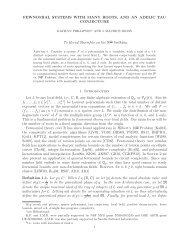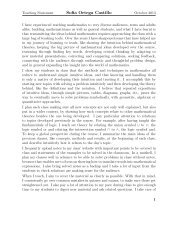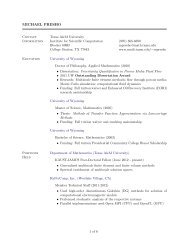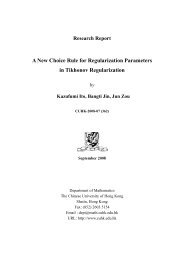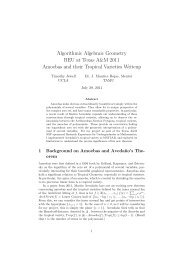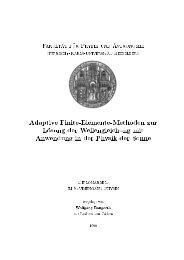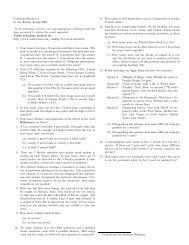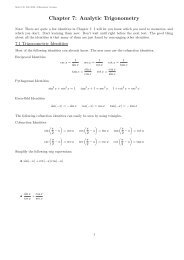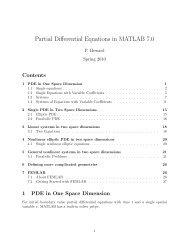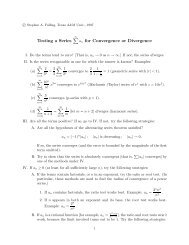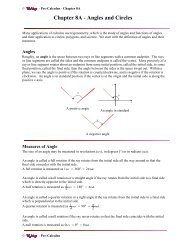Tensors: Geometry and Applications J.M. Landsberg - Texas A&M ...
Tensors: Geometry and Applications J.M. Landsberg - Texas A&M ...
Tensors: Geometry and Applications J.M. Landsberg - Texas A&M ...
You also want an ePaper? Increase the reach of your titles
YUMPU automatically turns print PDFs into web optimized ePapers that Google loves.
2.2. Groups <strong>and</strong> representations 31<br />
Example 2.2.1.2. Here are some actions: g ∈ GL(V ) acts on<br />
(1) V ∗ by α ↦→ α ◦ g −1 .<br />
(2) End(V ) by f ↦→ g ◦ f.<br />
(3) A second action on End(V ) is by f ↦→ g ◦ f ◦ g −1 .<br />
(4) The vector space of homogeneous polynomials of degree d on V for<br />
each d by P ↦→ g · P,where g · P(v) = P(g −1 v). Note that this<br />
agrees with (1) when d = 1.<br />
(5) Let V = C2 � �<br />
a b<br />
so the st<strong>and</strong>ard action of ∈ GL(V ) on C<br />
c d<br />
2 is,<br />
� � � �� �<br />
x a b x<br />
↦→ . Then GL2 also acts on C<br />
y c d y<br />
3 by<br />
⎛ ⎞<br />
x<br />
⎛<br />
a<br />
⎝y⎠<br />
↦→ ⎝<br />
z<br />
2 ac c2 2ab ad + bc 2cd<br />
b2 bd d2 ⎞⎛<br />
⎞<br />
x<br />
⎠⎝y⎠<br />
.<br />
z<br />
The geometry of this action is explained by Exercise 2.6.23<br />
These examples give group homomorphisms GL(V ) → GL(V ∗ ), GL(V ) →<br />
GL(End(V )) (two different ones) <strong>and</strong> GL(V ) → GL(S d V ∗ ), where S d V ∗<br />
denotes the vector space of homogeneous polynomials of degree d on V .<br />
Exercise 2.2.1.3: Verify that each of the above examples are indeed actions,<br />
e.g., show (g1g2) · α = g1(g2 · α).<br />
Exercise 2.2.1.4: Let<br />
�<br />
dim<br />
�<br />
V = 2, choose a basis of V so that g ∈ GL(V )<br />
a b<br />
may be written g = . Write out the 4 × 4 matrices for examples<br />
c d<br />
2.2.1.2.(2) <strong>and</strong> 2.2.1.2.(3).<br />
2.2.2. Modules <strong>and</strong> submodules. If W is a G-module <strong>and</strong> there is a<br />
linear subspace U ⊂ W such that g · u ∈ U for all g ∈ G <strong>and</strong> u ∈ U, then<br />
one says U is a G-submodule of W.<br />
Exercise 2.2.2.1: Using Exercise 2.2.1.4 show that both actions on End(V )<br />
have nontrivial submodules, in the first case (when dimV = 2) one can find<br />
two-dimensional subspaces preserved by GL(V ) <strong>and</strong> in the second there is a<br />
unique one dimensional subspace <strong>and</strong> an unique three dimensional subspace<br />
preserved by GL(V ).⊚<br />
A module is irreducible if it contains no nonzero proper submodules.<br />
For example, the action 2.2.1.2.(3) restricted to the trace free linear maps<br />
is irreducible.<br />
If Z ⊂ W is a subset <strong>and</strong> a group G acts on W, one says Z is invariant<br />
under the action of G if g · z ∈ Z for all z ∈ Z <strong>and</strong> g ∈ G.



